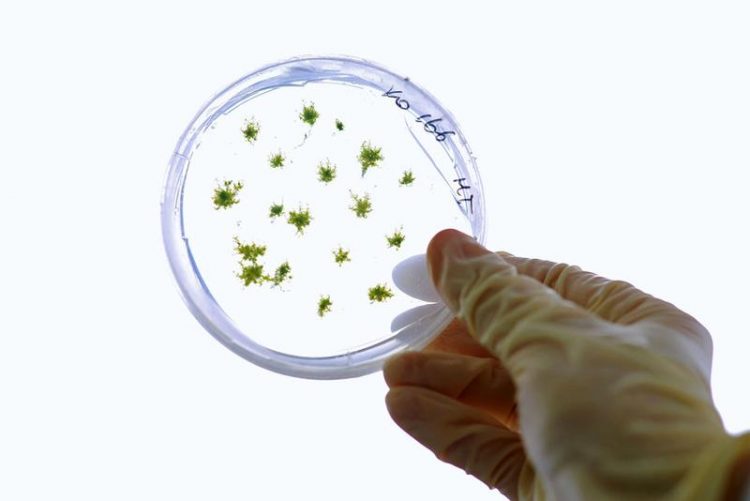How to target a gene

Moss plants on a Petri dish. Photo: Sigrid Gombert (University of Freiburg)
All living cells have invented mechanisms to protect their DNA against breaks during duplication and against damage by UV-light or chemicals. A team of biologists led by Prof. Dr. Ralf Reski from the Faculty of Biology of the University of Freiburg, Germany has now found that members of the RecQ family function in development, DNA repair and gene targeting in the moss Physcomitrella patens.
Their results were published in the journal Plant Cell and may hold the key to a precise engineering of plant genomes including crop plants. The Julius-Kuehn-Institute, the German Federal Research Centre for Cultivated Plants in Quedlinburg and the INRA Centre de Versailles-Grignon, France contributed to the study.
RecQ proteins can be found in bacteria, fungi, animals and plants. Their function is best investigated in humans, because mutations in these genes lead to disease syndromes like Bloom, Werner or Rothmund-Thomson or to cancer. Their function in plants was less well understood.
The team now found that the two model species predominantly analyzed for DNA recombination, the flowering plant Arabidopsis thaliana and the moss Physcomitrella patens, differ specifically in their RecQ4 and RecQ6 genes. Engineering different transgenic plants, the scientists found that RecQ4 is important for normal moss development and for DNA repair, whereas RecQ6, which does not exist in Arabidopsis, strongly enhances gene targeting.
Gene targeting in moss was first published by Reski’s group in 1998 and since then was used to answer many fundamental questions in biology. Moreover, this method was used extensively in biotechnology to create and to exploit knock-out mosses.
“Ever since we published the first knock-out mosses 20 years ago, I was curious to understand why Physcomitrella is orders of magnitude more efficient in gene targeting than any other plant”, explains Reski. Several groups world-wide tried to answer this conundrum, albeit in vain. Teaming up with the experts in Quedlinburg and in Versailles has finally brought success.
“We are now planning to express the moss RecQ6 gene in flowering plants to see, if we can significantly enhance their gene targeting also. Thus, we could modify crop plants with outstanding precision in the future”, says Reski.
The biologists at the University of Freiburg are specialized in moss research and have made significant contributions to the development of mosses as global model organisms in biology and biotechnology. Ralf Reski is a biologist and professor of plant biotechnology at the University of Freiburg, Germany. He is also a member of the cluster of excellence BIOSS Center for Biological Signalling Studies and was a senior fellow at the Freiburg Institute for Advanced Studies (FRIAS) and its French counterpart the University of Strasbourg Institute for Advanced Study (USIAS).
Chair of Plant Biotechnology at the University of Freiburg
www.plant-biotech.net
Original publication: Gertrud Wiedemann, Nico van Gessel, Fabian Köchl, Lisa Hunn, Katrin Schulze, Lina Maloukh, Fabien Nogué, Eva L. Decker, Frank Hartung, Ralf Reski (2018): RecQ helicases function in development, DNA-repair and gene targeting in Physcomitrella patens. Plant Cell, DOI: 10.1105/tpc.17.006372.
Figure legend: Moss plants on a Petri dish.
Photo: Sigrid Gombert (University of Freiburg)
Contact:
Prof. Dr. Ralf Reski
Chair Plant Biotechnology
Faculty of Biology
University of Freiburg
Germany
Phone: +49 (0)761/203-6969
E-Mail: pbt@biologie.uni-freiburg.de
https://www.pr.uni-freiburg.de/pm-en/press-releases-2018/how-to-target-a-gene?se…
Media Contact
All latest news from the category: Life Sciences and Chemistry
Articles and reports from the Life Sciences and chemistry area deal with applied and basic research into modern biology, chemistry and human medicine.
Valuable information can be found on a range of life sciences fields including bacteriology, biochemistry, bionics, bioinformatics, biophysics, biotechnology, genetics, geobotany, human biology, marine biology, microbiology, molecular biology, cellular biology, zoology, bioinorganic chemistry, microchemistry and environmental chemistry.
Newest articles

First-of-its-kind study uses remote sensing to monitor plastic debris in rivers and lakes
Remote sensing creates a cost-effective solution to monitoring plastic pollution. A first-of-its-kind study from researchers at the University of Minnesota Twin Cities shows how remote sensing can help monitor and…

Laser-based artificial neuron mimics nerve cell functions at lightning speed
With a processing speed a billion times faster than nature, chip-based laser neuron could help advance AI tasks such as pattern recognition and sequence prediction. Researchers have developed a laser-based…

Optimising the processing of plastic waste
Just one look in the yellow bin reveals a colourful jumble of different types of plastic. However, the purer and more uniform plastic waste is, the easier it is to…



